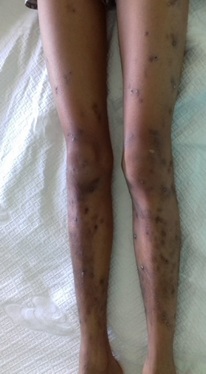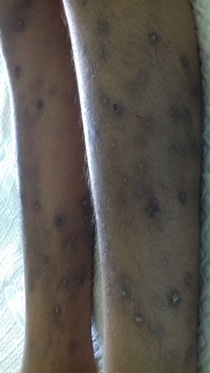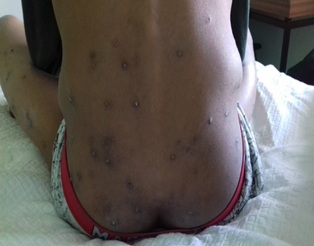
Itching For 3 Years
*Corresponding Author(s):
Sofia Soares BaptistaCentro Hospitalar Universitário Do Algarve – Hospital De Faro, Serviço De Pediatria, Adress: Rua Leão Penedo, 8000-386 Faro, Portugal
Tel:+351 962565126,
Email:sofiabaptista@campus.ul.pt
Case Presentation with image
The images show a 13-year-old Indian boy, previously healthy, that presented at our clinic with pruritic nodular lesions throughout the body, ongoing for 3 years, with no fever [1]. He received no treatments besides emollients. At observation he had a combination of multiple hyperpigmented macules, papules and nodules, symmetrically distributed on the extensor surfaces of both upper and lower extremities (Image 1a & 1b), lower back and buttocks (Image 1c). The remaining physical examination was unremarkable [2].
Image 1a, 1b And 1c
 Image 1a: Nodular and papular lesions in the extensor surface of lower extremities.
Image 1a: Nodular and papular lesions in the extensor surface of lower extremities.
 Image 1b. Nodular lesions in the legs.
Image 1b. Nodular lesions in the legs.
 Image 1c: Nodular Lesions on the lower back and buttocks.
Image 1c: Nodular Lesions on the lower back and buttocks.
Discussion
These lesions are typical of Prurigo Nodularis (PN), a chronic skin condition characterized by intensely pruritic multiple nodules. It can occur at any age, but it’s more in adults and rarely seen in children. The aetiology is unknown. There is no certainty whether PN is a primary cutaneous disorder or whether it is a reaction secondary to pruritus and itching-scratching triggered by other cause. Many people have an underlying condition that increase the risk of developing PN: atopic dermatitis, contact dermatitis, allergy, diabetes, kidney disease, hepatitis C, HIV, lymphoma and mental health conditions. Some people who develop PN don’ have other conditions linked to it. It is believed that chronic mechanical trauma causes thickening of the skin and leads to plaque-like or nodular lichenification, hyperkeratosis, and pigmentary changes. None of the conditions above was found to be the cause of the described case. Blood tests revealed no alteration and infectious screening was negative. The patient was treated with topical corticosteroids and oral antihistaminic, with a favourable evolution [3].
Treatment’s goal is to break the itch-scratch-itch cycle. The treatment options range from oral antihistaminic, oral or topical corticosteroids and ultraviolet therapy to immunomodulating agents in the most severe cases. Despite the difficult management with the several treatments available, is a benign condition with a good prognosis [4].
With this case we aim to alert to the possibility of the diagnosis of prurigo nodularis in pediatric age, even if it’s very rare. Overall, PN is a benign condition, but it can affect children’s quality of life if untreated. The images show the typical locations of the several lesions (macules, papules and nodules) that the Physician should be attentive when suspecting this condition [5].
Acknowledgements and Conflicts of Interest
The authors confirm that this manuscript has not been previously published and is not under evaluation for publication in any other journal.
The authors confirm that they did not receive financial or other kinds of support from any organization or institution to write or publish this manuscript.
The authors declare no conflicts of interest.
The authors confirm that this manuscript is in accordance with the ethical standards of the institutional, national research committee and the 1964 Helsinki Declaration and its later amendments or comparable ethical standards.
All authors have played an active role and contributed to the manuscript.
References
- Amer A, Fischer H (2009) Prurigo Nodularis in a 9-Year-Old Girl. Clinical Pediatrics 48: 93-95.
- Mullins TB, Sharma P, Riley CA, Sonthalia S (2022) Prurigo Nodularis. In: StatPearls . Treasure Island (FL): StatPearls Publishing.
- Williams K, Huang A, Belzberg M, Kwatra S (2020) Prurigo nodularis: Epidemiology and clinical features. J Am Acad Dermatol 83: 1559-1565.
- Williams K, Huang A, Belzberg M, Kwatra S (2020) Prurigo nodularis: Pathogenesis and management. J Am Acad Dermatol 83: 1567-1575.
- Murakami Y, Sugiyama A, Ideguchi H, Murakami Y, Amimoto Y, et al. (2020) Three cases of atopic dermatitis children with intractable prurigo nodularis. Arerugi 69: 213-217.
Citation: Baptista SS, Coelho IP, Fernandes AC, Dias F, Gama G (2023) Itching For 3 Years. J Neonatol Clin Pediatr 10: 103.
Copyright: © 2023 Sofia Soares Baptista, et al. This is an open-access article distributed under the terms of the Creative Commons Attribution License, which permits unrestricted use, distribution, and reproduction in any medium, provided the original author and source are credited.

